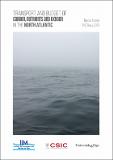Por favor, use este identificador para citar o enlazar a este item:
http://hdl.handle.net/10261/165428COMPARTIR / EXPORTAR:
 SHARE
BASE SHARE
BASE
|
|
| Visualizar otros formatos: MARC | Dublin Core | RDF | ORE | MODS | METS | DIDL | DATACITE | |

| Campo DC | Valor | Lengua/Idioma |
|---|---|---|
| dc.contributor.advisor | Pérez, Fiz F. | - |
| dc.contributor.advisor | Francés, G. | - |
| dc.contributor.author | Fontela, Marcos | es_ES |
| dc.date.accessioned | 2018-05-31T11:43:06Z | - |
| dc.date.available | 2018-05-31T11:43:06Z | - |
| dc.date.issued | 2018 | - |
| dc.identifier.uri | http://hdl.handle.net/10261/165428 | - |
| dc.description | 173 pages, 64 figures, 17 tables | es_ES |
| dc.description.abstract | This thesis project is structured in five parts subdivided in eight chapters and four appendices, whose contents, results and main findings are briefly summarized below. Part I introduces the state of the art in the research field and sets the aim of the PhD thesis. It is subdivided in four chapters. This introductory part starts in the Chapter 1 with a general background of marine biogeochemical cycles, putting emphasis on the oceanic carbon cycle. The physical oceanography of the North Atlantic it is summarized in Chapter 2, with a detailed description of the eastern subpolar region that is the main area of study in this thesis. This chapter also address the large scale circulation in the Atlantic, the main mode of climate variability and the current state of knowledge about the subpolar water masses. In Chapter 3 the present concern about the implications of anthropogenic perturbations at geological scale is presented under the relatively new concept of Anthropocene, and chronology approaches in deep-sea sediments are suggested. At last, in Chapter 4 the main and specific objectives of this thesis are provided. From now on, each one of the subsequent parts of the thesis are related with specific objectives. With the exception of the introductory chapter in Part IV (Chapter 7), each chapter is designed as an independent entity, and structured in sections as a typical scientific publication. In Part II the organic component of the carbon cycle is addressed. After an introduction to the dissolved organic carbon (DOC) in the ocean carbon cycle, in the Chapter 5 is constructed a budget of DOC for the area of study combining water masses transports with source water type DOC characterizations. The budget is extended until subtropical latitudes (24ºN), where the implications of the Atlantic Meridional Overturning Circulation in the total exportation of DOC mediated by the Atlantic Ocean is evaluated for the first time. | es_ES |
| dc.description.abstract | In Part III a complete biogeochemical budget for the region of study is applied. Chapter 6 update the actual state of knowledge of carbon, nutrients and oxygen cycling in the eastern subpolar North Atlantic. Combining long-term mass-balanced transports (2002-2016) across the OVIDE section with public available data from a wide range of sources, a total budget of the carbon cycle in the subpolar gyre that includes for the first time carbon variables, nutrients and oxygen was done. Under an inverse lineal model approach, a quantification of the exportation of organic and inorganic carbon as well as the oxygen flux in the eastern subpolar North Atlantic is given. The geological part of the thesis dissertation is the Part IV. In the Chapter 7 the methodological features of the innovative radiometric technique applied to date superficial deep-sea marine sediments is fully described. To our knowledge, this is the first time that high-resolution low level background gamma spectrometry with two simultaneous hyper-pure germanium (HPGe) detectors is used to measure radioactivity in deep-sea samples. In Chapter 8 are showed the results of two superficial deep-sea cores located at different basins in the subpolar North Atlantic dated with the 210Pb method. Joining geochronology information with geochemical characterization, carbon fluxes to the sediments since the Anthropocene have been estimated. As an opening approach into carbon sedimentation in the subpolar North Atlantic, the projection of the results at basin-scale can give a first guess of the magnitude of carbon currently exported into the sediments. | es_ES |
| dc.description.abstract | The thesis dissertation ends with the main conclusions derived of this work in the Part V. In order to ease the reading progress, all the references are grouped together as a separate section. Finally, the four appendices at the end of the volume provide: (I) a complete list of the acronyms, abbreviations and symbols used along with their explanations, (II) a comprehensive list of all the figures and (III) tables indicating the pages where they appear; and (IV) a summary of the thesis dissertation in Spanish | es_ES |
| dc.language.iso | eng | es_ES |
| dc.relation.isversionof | Publisher's version | es_ES |
| dc.rights | openAccess | es_ES |
| dc.title | Transport and budget of carbon, nutrients and oxygen in the North Atlantic | es_ES |
| dc.type | tesis doctoral | es_ES |
| dc.description.peerreviewed | Peer reviewed | es_ES |
| dc.relation.csic | Sí | es_ES |
| oprm.item.hasRevision | no ko 0 false | * |
| dc.type.coar | http://purl.org/coar/resource_type/c_db06 | es_ES |
| item.cerifentitytype | Publications | - |
| item.openairecristype | http://purl.org/coar/resource_type/c_18cf | - |
| item.grantfulltext | open | - |
| item.openairetype | tesis doctoral | - |
| item.fulltext | With Fulltext | - |
| item.languageiso639-1 | en | - |
| Aparece en las colecciones: | (IIM) Tesis | |
Ficheros en este ítem:
| Fichero | Descripción | Tamaño | Formato | |
|---|---|---|---|---|
| Tesis_Marcos_Fontela.pdf | 50,52 MB | Adobe PDF |  Visualizar/Abrir |
CORE Recommender
Page view(s)
445
checked on 05-may-2024
Download(s)
548
checked on 05-may-2024
Google ScholarTM
Check
NOTA: Los ítems de Digital.CSIC están protegidos por copyright, con todos los derechos reservados, a menos que se indique lo contrario.
